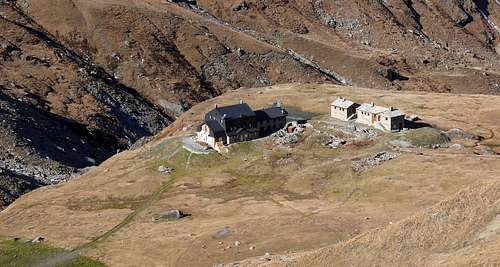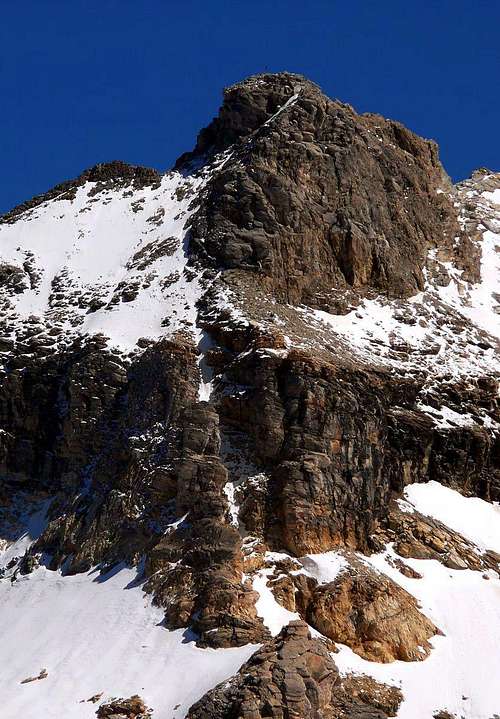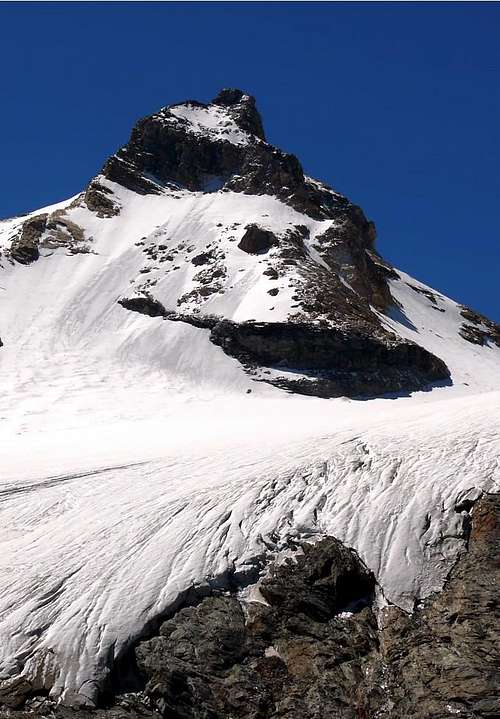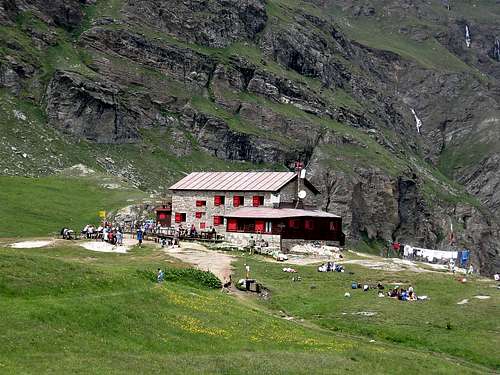-
 12175 Hits
12175 Hits
-
 91.45% Score
91.45% Score
-
 35 Votes
35 Votes
|
|
Mountain/Rock |
|---|---|
|
|
45.49510°N / 7.06473°E |
|
|
11112 ft / 3387 m |
|
|
Overview
- Jul 13th, 2017 Inherited the page from Andrea.it.
- Aug 29th, 2017 Started to modify the page and the other sections.
It looks like highest point of the rocky ridge starting from Col della Tsanteleina and shares out the Goletta Glacier with the heading glaciers of Valle di Rhêmes. It's one of the most goodlooking mountain of the area, expecially if seen from the Village of Rhêmes Notre Dame, sited just to the North. The name "Granta Parei", in the local dialect, is clearly arising from the italian name "Grande Parete", which in english means "Big Wall". In fact, this mountain is basically a four angles pyramid, with the huge Eastern rocky Wall rising for about 500 meters above the glacier. It's the first showy thing to see when coming from the bottom of the valley, where offers the Northern and Eastern Walls. Despite the nice shape, this mountain is for the most part composed of bad quality rocks, expecially on the Western Face (on which passes the Normal Way or Normal Route), mixed with icy gullies, a rocky-detritic narrow stretch, followed by a final part rocky-debris or snow slopes, immediately below the summit collar 3.385 meters, between the two Summits.
First Ascents
- First on the Summit (North-northwest Ridge and West Slope in final part): R. C. Nichols, T. Blanford and E. P. Rowsell with mountain Guides J. V. Favret and N. Jacod, (Aug 22th, 1863).
- In winter: Emanuele Andreis, F. P. and S. Ceresa, M. De Benedetti and R. Henking, by ski through the West Slope along the Standard Via.
- West Face, Direct Route to Southern Summit: Osvaldo Cardellina, Sergio Roverso and Nino Trapani, (Jul 14th, 1974), in day from Rhêmes Notre Dames and crossing on Glacier de Goletta to Traversière Becca with descent towards Bassac Déré Pass.
- Western Slope, Normal Route: William Auguste Brevoort Coolidge and mountain Guide Christian Almer, (Sep 25th, 1886).
- West Wall, Direct Via to Northern Summit: Osvaldo Cardellina and Reinhart Lohrmann, (Jul 28th, 1968), and crossing Goletta's Glacier towards Traversière Becca and Bassac Déré Pass.
- Northwest Little Couloir: Lorenzo Merli and Raffaele Piller, (July 10th, 1983), from Benevolo Shelter through Goletta's Glacier.
- Northwest Ridge: R. C. Nichols, T. Blanford and E. P. Rowsell with mountain Guides J. V. Favret and N. Jacod, (Aug 22th, 1863); first integral ascent: A. Garino with mountain Guide Casimiro Thérisod, (Aug 15th, 1901).
- North Wall: P. F. Quaini, (1913) in descent; Erasmo Barisone, I. Brosio and O. Crudo, (May 25th, 1924), in ascent.
- Northeast Ridge: Pompeo Viglino with Companions (1911), Barberi, Gerboni and Gherra, (Aug 13th, 1929).
- East Great Wall (Folli/Tardito Via): Mimo Folli and Aldo Tardito, (Aug 1/2/3th, 1968).
- Eastern Goulotte ("Aragon"), Difficulty V-I4+-M6-A1; Length: 500m: mountain Guide Ezio Marlier, solo, (Jan 3/4th, 2007), Benevolo.
- East-southeast Wall: Luigi Binaghi, Aldo Bonacossa and Ninì Pietrasanta, (Sep 06th, 1962).
- Southern Crest: A. and E. Pigeon with mountain Guides Jean Joseph Maquignaz and Daniel Balley, (Jul 26th, 1875).
- Southwest Flank: Giovanni Bobba and Casimiro Thèrisod, (Jul 24th, 1888).
- West-sothwest Edge of triangular West-southwest Face: Osvaldo Cardellina, solo, (Jul 20th, 1997), in day from Pellaud Village.
Getting There from France & Switzerland
From Italy- From Valgrisenche: From the motorway A5 Monte Bianco (from Geneve, Turin, Milan), take the exit Aosta Ovest and follow the direction to Arvier-Valgrisenche.
- From Val di Rhêmes:
- From the motorway A5 Monte Bianco (from Geneve, Turin, Milan), take the exit Aosta Ovest and follow the direction to Villeneuve-Val di Rhêmes.
- From Val d'Isere: From the village of Val d'Isere, enter in the area called "Reserve Naturelle de la Grande Sassiere". From here, few routes, through Col de Rhêmes Goletta and Col de la Tsanteleina, permit to reach the Italian side at the foot of this mountain.
- Is possible to reach the Aosta Valley also through the: France-pass of Piccolo St. Bernardo (closed in winter). France-Tunnel of Mont Blanc. Swiss-Tunnel of Grand St. Bernardo. Swiss-Pass of Grand St. Bernardo (closed in winter).
BASE APPROACH to NORMAL ROUTE with two VARIANTS
Approach to Goletta's Glacier at the base of standard Route From Federico Benevolo Refuge go down (SW direction) at small bridge (2.269m) over Rhêmes Dora Stream; by a diagonal path 13d, HRG (High Glacial Route) go to the fork (2.420m, (little cairn); leaving to the left (South) the path 13c (toward Truc Saint-Hélène and Tsanteleina Lake), turn right (Northwest) climbing the grassy promontory (2.615m). Change again direction (South-southwest) and reach the last ramification of Granta Parei long North-northeast Spur. Continue below the crest to the right (West), by obvious trace and white limestones debris to quota (3.078m) at the beginning of North-northeast Ridge; turn 90 degrees West and cross the Higher Goletta Glacier staying high, below the Northern Face, skirting North-northwest Ridge at about 3.080/90m. Turn South and, by a progressive diagonal ascent, reach the start of the Western Slope routes or Normal Routes. (2h'00/2h'15).WESTERN STANDARD VIA & VARIANTS
A) - Western Slope, Normal Route towards Saddle (3.385m~) between the two Summits: to cross in right (S) half West Slope moving in centre; to go up the snowy slope (30°) up to a rocky narrowing (forced passage, very often frozen; dangerous for rocks falls together with numerous a group of rope climbers); to climb in right (S), by greats footholds with ice, also in left through a frozen "chimney" and to reach at higher debris and snowy slope (always "verglass"). To aim the "carving" between two summits, more to South. To cross in right (S) toward major Summit (3.387m) and in left (N), by a easy but exposed small crest, to North or traditional Summit (3.383m~). (F+; 1h'30).Main Climbing Routes
|
Western Slope (Normal Route): from Refuge Federico Benevolo 4 hours (F+). Northwest Little Couloir: from Ref. Benevolo 4/5 hours (AD-). Northwest Ridge from Ref. Benevolo 4/4.30 hours (PD+). Northern icy Face: from Ref. Benevolo 4/5 hours III°/45° (AD). Eastern Great Wall (Folli/Tardito Via): from Glacier of Tsanteleina VI°+/A2 (ED) (first ascent 10.30 hours). Eastern Goulotte ("Aragon"):, two days with difficulty V-I4+-M6-A1; length: 500 meters, from Benevolo Shelter. East-southeast Wall: from Ref. Benevolo 5/7 hours IV° (AD+). Southern Crest: from Ref. Benevolo 4/5 hours III°/IV° (AD).
|
Huts

Essential Gear
Mountaineering equipment, including rope, iceaxe, and crampons.
Red Tape
The Eastern side of the valley belongs to Gran Paradiso National park, the Western one is out of the boundaries of the Park ... but nature must be respected.Campings
Remember that free camping is forbidden (except for emergency reasons, over 2.500m, from darkness until dawn).Mountain Conditions
- You can get meteo information at the official site of the Regione Valle d'Aosta:
- Valle d'Aosta Meteo
- Meteo: You can find more weather information on the website 3B Meteo:
- Meteo Rhemes Notre Dame
Webcam
- WEBCAM on Aosta Valley:
- Webcam
Books and Maps
BOOKS:- "Guida delle Alpi Occidentali" di Giovanni Bobba e Luigi Vaccarone C.A.I. Sezione di Torino Volume II (parte II), 25 Maggio 1896.
- "Guida dei Monti d'Italia-Gran Paradiso Parco Nazionale" E. Andreis, R. Chabod, M. C. Santis, Club Alpino Italiano/Touring Club Italiano, prima Ed. 1939; seconda Ed. 1963; terza Ed.
- "Guida della Regione Autonoma Valle d'Aosta" di Mario Aldrovandi,Ed. S.P.E. di Carlo Fanton, Torino 31 Dicembre 1964.
- "Rifugi e bivacchi in Valle d'Aosta", di Cosimo Zappelli aggiornata da Pietro Giglio, Musumeci Editore, Luglio 2002.
- "Diari Alpinistici" di Osvaldo Cardellina e Indice Generale accompagnato da Schedario Relazioni Ascensioni 1964-2019 (inediti).
MAPS:
- Kompass "Gran Paradiso Valle d'Aosta Sentieri e Rifugi" Carta Turistica 1:50.000.
- Enrico Editore Ivrea-Aosta "Gruppo del Gran Paradiso" 1:50.000.
- I.G.C. Istituto Geografico Centrale Torino "Valsavarenche Val di Rhemes Valgrisenche Parco Nazionale del Gran Paradiso", (carta n° 102), 1:25.000.
- I.G.C. Istituto Geografico Centrale Carta dei sentieri e dei rifugi "Il Parco Nazionale del Gran Paradiso" 1:5.0000.
Important Information
- REGIONE AUTONOMA VALLE D'AOSTA the official site.
- FONDAZIONE MONTAGNA SICURA Villa Cameron, località Villard de la Palud n° 1 Courmayeur (AO) Tel: 39 0165 897602 - Fax: 39 0165 897647.
- SOCIETA' GUIDE ALPINE DEL GRAN PARADISO Comune di Valsavarenche.
- A.I.NE.VA. (Associazione Interregionale Neve e Valanghe).

Useful numbers
- Protezione Civile Valdostana località Aeroporto n° 7/A Saint Christophe (Ao) Tel. 0165-238222.
- Bollettino Meteo (weather info) Tel. 0165-44113.
- Unità Operativa di Soccorso Sanitario Tel. 118.
























